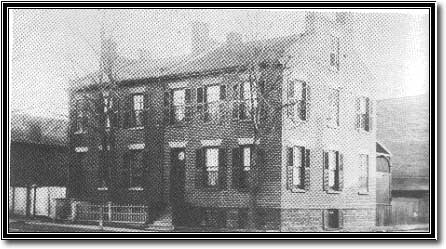One of the key features of 401 Richmond are its over 800 grand double-hung windows, consisting of wooden cross bars with small window panes in between. These windows had been in a very poor state of repair and rather than discarding them, a conscious decision was made to restore them.
Mike demonstrated this painstaking process, from taking the windows out of the wall, removing the old glass, heat stripping of several layers of old paint and putty, to replacing the rotted wooden cross bars, reglazing, puttying, painting and weather stripping. This process originally used to take 3 hours per window sash, but now Mike and his crew are able to completely restore one of these windows in 45 minutes. Of the 800 windows, about 80% are restored now. I was just marveling at the painstaking nature of this process and the dedication of the people involved to retaining and refurbishing the original architectural features.

Mike Moody demonstrates window restoration
Today the complex at 401 Richmond houses around 150 tenants, many of them from the arts and social innovation communities and the owner, Urbanspace Property Group, has made a commitment to keeping the rents below market to give these small entrepreneurs and organizations some assistance.
Just a few minutes up Spadina Avenue was our next stop on our architectural tour: the Anshei Minsk Synagogue is located at 10 St. Andrews Street, just 2 streets north of the Dundas and Spadina intersection, Toronto’s largest Chinatown area. This area adjoins the Kensington area which used to be Toronto’s original Jewish area. Most of the original Jewish residents have relocated over the past few decades to suburban areas north of the city. Opened in 1930, the Anshei Minsk Synagogue was one of about 30 synagogues in the downtown core when there were still about 30 synagogues in this area. Today there is only one with daily prayer service.

The Anshei Minsk Synagogue
Rabbi Shmuel Spero talked to the crowd, telling them about Toronto’s Jewish history and the transformation of the historic Kensington area. Nowadays more Jewish people moving back downtown.
The Minsk has the feel of a traditional eastern European synagogue of the 1930s. The main and upper floors are made of hardwood and stained glass windows feature the Star of David. An ornate chandelier, hanging from the ceiling, also features Jewish symbols. I wish we had had more time to sit down and listen to Rabbi Spero, but we had to get going to make it to our 3 pm tour at the Gladstone Hotel. When we got there about 40 or 50 people were already waiting for the tour, testimony to the fact that Doors Open in general and the Gladstone Hotel specifically were a key destination for many Torontonians this Sunday afternoon.

Rabbi Spero tells us about Kensington’s history
The historic Gladstone Hotel is another heritage property owned by Urban Space Properties. Another member of the prominent Zeidler family, Christina Zeidler, was responsible for reinventing this historic property. Ground for the original hotel was broken in 1889 and the original owner, Susanna Robinson, was a widow who operated and lived at the hotel with 13 children. This hotel was originally located right opposite 3 major train stations: the Grand Trunk Railway, the CPR and the CNR. None of the train stations are in existence any longer, and the Gladstone is no longer the last place to get liquor before reaching Hamilton as it once was.

The Gladstone Hotel
The Gladstone is the oldest continuously operating hotel in Toronto, built in the Richardsonian Romanesque Style which was so popular during Victorian times. Two restored pillars in the hotel’s Melody Bar are unique in Toronto for their faux marble finish, using a true European fresco technique.
The Gladstone’s elevator is one of the last hand-operated elevators in Toronto and the common areas on the second, third and fourth floors are used for photo exhibitions. The second floor provides ten adjoining rooms for meetings, workshops or exhibitions. During our visit there were a number of different artists on display, one piece of art in particular caught my attention: a large framed photo montage with many small photos depicting “Things I Left In The Fridge Too Long”. I thought this was a particularly humorous and relevant piece of art and I think I even recognized some of the items shown on the pictures from my own failed refrigeration experiments….

One of the hotel rooms at the Gladstone
We had a chance to see 2 of the 37 hotel rooms, all of which are unique and designed by different artists. The hotel also features two special suites: the two-story Tower Suite, also known as the “Rock Star Suite”, and the luxurious third floor Corner Suite, both of which provide magnificent views of the city. Unfortunately we weren’t able to catch a glimpse of these special rooms, something that would have interested me greatly.

My savoury lunch at the Ballroom Café
After our tour it was close to 4 pm and Doors Open 2006 had officially come to an end. We took the opportunity to sit down in the Ballroom Café, located right next to the beautifully restored 250 seat Ballroom at the Gladstone Hotel. We snuck in our brunch order just before brunch was finished. I savoured a Grilled Vegetable Mufuletta Sandwich with a tasty side salad of mixed greens in a balsamic vinaigrette while Shauna partook of the Eggs Florentine with salmon. The food was delicious and well-deserved after a whole day of explorations, celebrating Toronto’s architectural heritage and social history.
Final lesson: Toronto’s architectural treasures are all about the people and the communities that they serve and Doors Open is a great teaching tool to learn about Toronto’s social history.

Two young girls having fun, dancing to the band at the Gladstone




